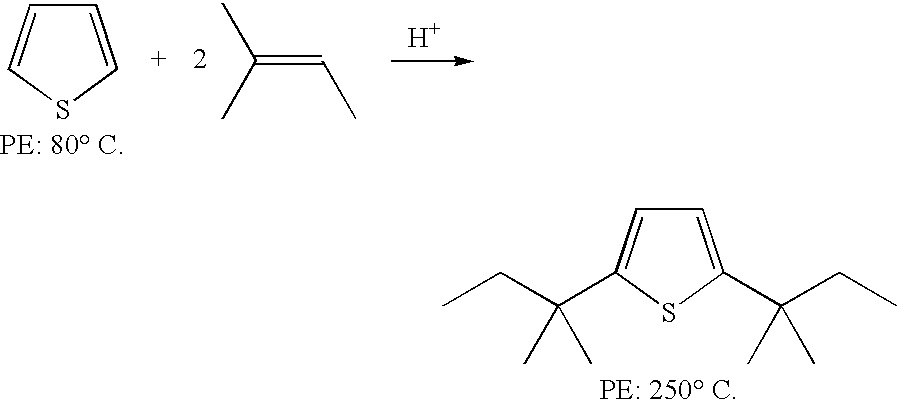Process for the production of gasoline with a low sulfur content comprising a hydrogenation, a fractionation, a stage for transformation of sulfur-containing compounds and a desulfurization
- Summary
- Abstract
- Description
- Claims
- Application Information
AI Technical Summary
Benefits of technology
Problems solved by technology
Method used
Image
Examples
example 1
[0137] A catalytic cracking gasoline whose characteristics are presented in table 1 is separated into two fractions (stage c): a light fraction whose fraction point corresponds to a temperature of 63.degree. C. and a heavy fraction. The light fraction represents 25% by weight of the starting gasoline and combines 88% of the olefinic compounds that have 5 carbon atoms that were present in the starting gasoline and 23% of the olefins that have 6 carbon atoms.
[0138] The characteristics of the separation column are as follows: 30 theoretical plateaus, pressure in the reflux flask=5 MPa, feed temperature 100.degree. C.
[0139] The characteristics of the light fraction and the heavy fraction are presented in Table 1.
1 Catalytic Cracking Gasoline Light Heavy Total Fraction Fraction Gasoline PI-63 63-220.degree. C. REFRACTION INDEX AT 20.degree. C. 1.43 1.38 1.45 DENSITY 15 / 4 0.76 0.67 0.79 IBr (g / 100 g) 78 166 48 MAV (mg / g) 6.4 5.2 6.8 TOTAL NITROGEN (mg / l) 40 2.7 50 RON 93.0 95.8 92.0 MON 8...
example 2 (
According to the Invention)
[0144] The gasoline whose characteristics are described in Example 1 is subjected to a hydrogenation treatment of diolefins (stage a) under conditions where the light sulfur-containing compounds that are present in the feedstock are partly converted into heavier compounds (stage b carried out simultaneously to stage a).
[0145] This treatment is carried out in a reactor that operates continuously and with an upward flow. The catalyst is a catalyst HR945 that is marketed by the Procatalyse Company. The reaction is carried out at 160.degree. C. under a total pressure of 13 bar, with a volumetric flow rate of 6 h.sup.-1. The H2 / feedstock ratio, expressed in liter of hydrogen per liter of feedstock, is 10.
[0146] The characteristics of the effluent after hydrogenation of the diolefins and conversion of the light compounds that are present in the gasoline are presented in Table 3.
3 Catalytic Cracking Gasoline Total Gasoline after Gasoline Treatment REFRACTTON INDE...
PUM
 Login to View More
Login to View More Abstract
Description
Claims
Application Information
 Login to View More
Login to View More - R&D
- Intellectual Property
- Life Sciences
- Materials
- Tech Scout
- Unparalleled Data Quality
- Higher Quality Content
- 60% Fewer Hallucinations
Browse by: Latest US Patents, China's latest patents, Technical Efficacy Thesaurus, Application Domain, Technology Topic, Popular Technical Reports.
© 2025 PatSnap. All rights reserved.Legal|Privacy policy|Modern Slavery Act Transparency Statement|Sitemap|About US| Contact US: help@patsnap.com


